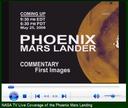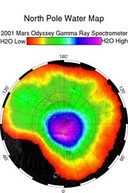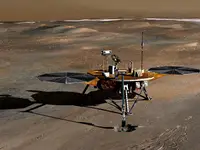Phoenix Lands Safely on Mars - Watch NASA Coverage Here
 |
May 25, 2008 - US Memorial Day Weekend
At approximately 8PM EDT the Mars probe "Phoenix" landed safely on target on the Martian 'north pole'. EDITOR'S NOTE: Scroll down for more videos
PHOENIX MARS LANDER - Exploring the arctic plain of Mars
Overview
 |
Click PLAY below to watch the NASA Phoenix mission promo video
 |
The complement of the Phoenix spacecraft and its scientific instruments are ideally
suited to uncover clues to the geologic history and biological potential of the Martian
arctic. Phoenix will be the first mission to return data from either polar region providing
an important contribution to the overall Mars science strategy "Follow the Water" and
will be instrumental in achieving the four science goals of NASA's long-term Mars
Exploration Program:
--Determine whether Life ever arose on Mars
--Characterize the Climate of Mars
--Characterize the Geology of Mars
--Prepare for Human Exploration
The Phoenix Mission has two bold objectives to support these goals, which are to (1) study the history of water in the Martian arctic and (2) search for evidence of a habitable zone and assess the biological potential of the ice-soil boundary.
Click PLAY below to watch an animated conception of the landing



